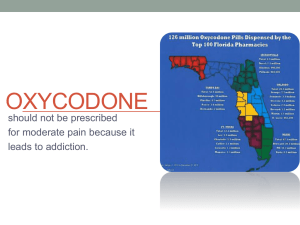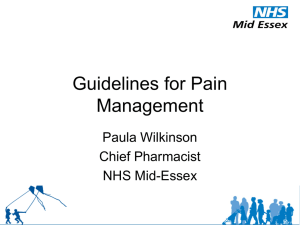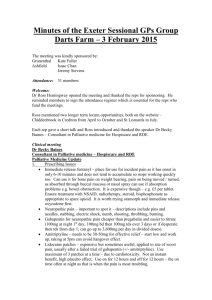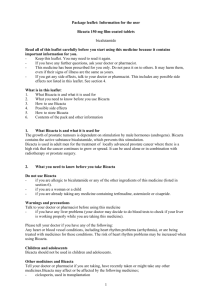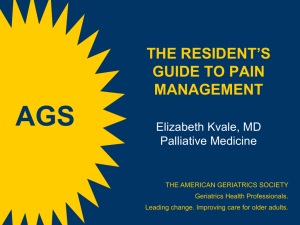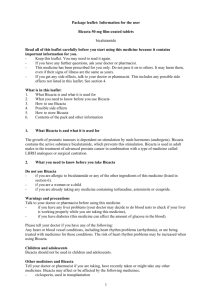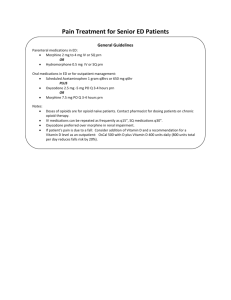Oxycodone Vitabalans film
advertisement
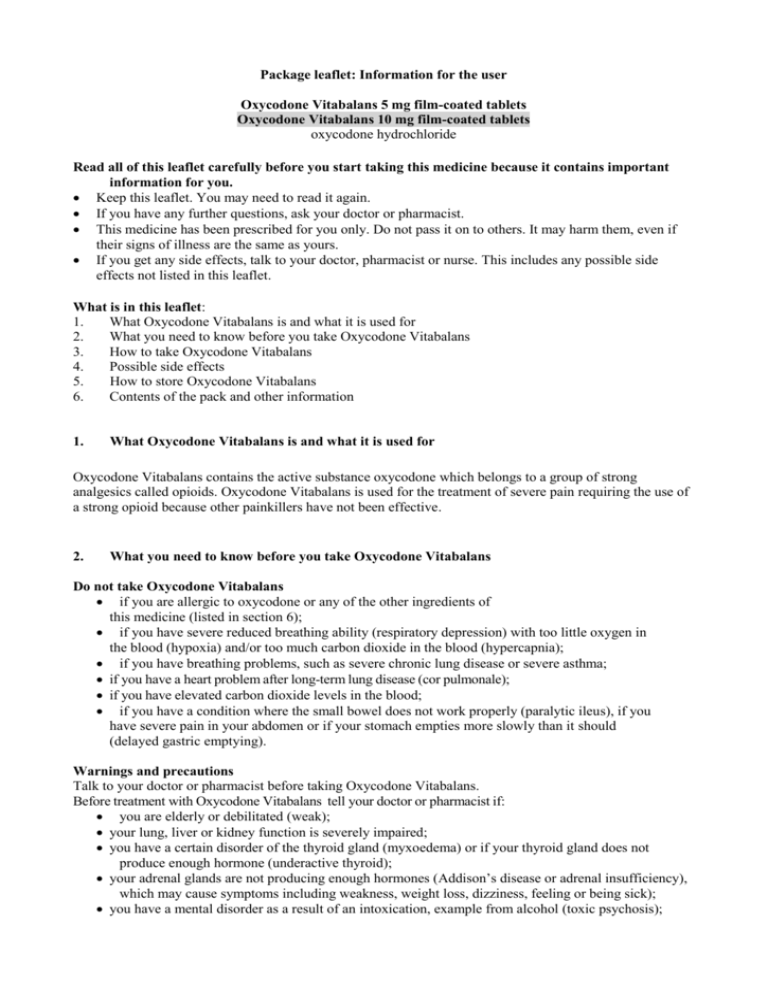
Package leaflet: Information for the user Oxycodone Vitabalans 5 mg film-coated tablets Oxycodone Vitabalans 10 mg film-coated tablets oxycodone hydrochloride Read all of this leaflet carefully before you start taking this medicine because it contains important information for you. Keep this leaflet. You may need to read it again. If you have any further questions, ask your doctor or pharmacist. This medicine has been prescribed for you only. Do not pass it on to others. It may harm them, even if their signs of illness are the same as yours. If you get any side effects, talk to your doctor, pharmacist or nurse. This includes any possible side effects not listed in this leaflet. What is in this leaflet: 1. What Oxycodone Vitabalans is and what it is used for 2. What you need to know before you take Oxycodone Vitabalans 3. How to take Oxycodone Vitabalans 4. Possible side effects 5. How to store Oxycodone Vitabalans 6. Contents of the pack and other information 1. What Oxycodone Vitabalans is and what it is used for Oxycodone Vitabalans contains the active substance oxycodone which belongs to a group of strong analgesics called opioids. Oxycodone Vitabalans is used for the treatment of severe pain requiring the use of a strong opioid because other painkillers have not been effective. 2. What you need to know before you take Oxycodone Vitabalans Do not take Oxycodone Vitabalans if you are allergic to oxycodone or any of the other ingredients of this medicine (listed in section 6); if you have severe reduced breathing ability (respiratory depression) with too little oxygen in the blood (hypoxia) and/or too much carbon dioxide in the blood (hypercapnia); if you have breathing problems, such as severe chronic lung disease or severe asthma; if you have a heart problem after long-term lung disease (cor pulmonale); if you have elevated carbon dioxide levels in the blood; if you have a condition where the small bowel does not work properly (paralytic ileus), if you have severe pain in your abdomen or if your stomach empties more slowly than it should (delayed gastric emptying). Warnings and precautions Talk to your doctor or pharmacist before taking Oxycodone Vitabalans. Before treatment with Oxycodone Vitabalans tell your doctor or pharmacist if: you are elderly or debilitated (weak); your lung, liver or kidney function is severely impaired; you have a certain disorder of the thyroid gland (myxoedema) or if your thyroid gland does not produce enough hormone (underactive thyroid); your adrenal glands are not producing enough hormones (Addison’s disease or adrenal insufficiency), which may cause symptoms including weakness, weight loss, dizziness, feeling or being sick); you have a mental disorder as a result of an intoxication, example from alcohol (toxic psychosis); your prostate is abnormally enlarged; you are addicted to alcoholism or are undergoing alcohol withdrawal treatment; you are, or were previously, dependent on strong pain killers (opioids); you have inflammation of the pancreas (which causes severe pain in the abdomen and back) or problems with your gall bladder; you have inflammatory bowel disorders (inflammatory conditions of the colon and small intestine); you have difficulty or pain passing urine; you have hypovolaemia (decrease in the volume of the circulating blood); you have a severe headache or feel sick as this may indicate that the pressure in your skull is increased; you have low blood pressure or feel dizzy standing up; you have epilepsy or a tendency to seizures; you are taking a type of medicine known as monoamine oxidase inhibitors (medicines used to treat depression or Parkinson’s disease). If you are going to have an operation, please tell the doctor at the hospital that you are taking Oxycodone Vitabalans. Long-term use of oxycodone can lead to tolerance. This means that you may need a higher dose to achieve the desired pain relief. Oxycodone Vitabalans can also lead to physical dependence and withdrawal syndrome can occur if use of oxycodone is stopped suddenly. If therapy with oxycodone is no longer required it may be advisable to reduce the daily dose gradually in order to avoid the occurrence of withdrawal symptoms. The risk of developing physical or psychological dependence is low when oxycodone is used according to instructions to patients suffering from chronic pain. You may discuss about this with your doctor. Hyperalgesia (an increased sensitivity to pain) that will not respond to a further dose increase of oxycodone may very rarely occur, particularly in high doses. An oxycodone dose reduction or change to an alternative opioid may be required. Other medicines and Oxycodone Vitabalans Tell your doctor or pharmacist if you are taking, have recently taken or might take any other medicines. Tell your doctor or pharmacist if you are taking: strong medicines to treat pain (for example other opioids); medicines to help you sleep or to treat anxiety (for example sedatives and hypnotics); medicines to treat depression; medicines to treat psychiatric or mental disorders (such asantipsychotics); medicines used during surgery (anaesthetics); muscle relaxants; medicines to treat allergic reactions (antihistamines); medicines to treat nausea and vomiting (antiemetics); monoamine oxidase inhibitors (MAO inhibitors) or if you have taken MAO inhibitors during the last two weeks. MAO inhibitors are medicines used to treat depression or Parkinson’s disease; medicines used to treat Parkinson’s disease; macrolide antibiotics (e.g. clarithromycin, erythromycin and telithromycin); azol-antifungal medicines (e.g. ketoconazole, voriconazole, itraconazole, and posaconazole); protease inhibitors used to treat HIV (e.g. boceprevir, ritonavir, indinavir, nelfinavir and saquinavir); cimetidine (a medicine for stomach ulcers, indigestion or heartburn); rifampicin (an antibiotic used for tuberculosis); carbamazepin or phenytoin (used for epilepsy); St John´s Wort (hypericum, in some natural products); paroxetine (antidepressant); quinidine (medicine against cardiac arrhythmias); anticoagulants (medicines to stop blood from clotting). Oxycodone Vitabalans with food, drink and alcohol Oxycodone Vitabalans can be taken together with or without food with a sufficient amount of liquid. Drinking alcohol whilst taking Oxycodone Vitabalans may make you feel sleepier or increase the risk of serious side effects such as shallow breathing with a risk of stopping breathing, and loss of consciousness. It is recommended not to drink alcohol while you’re taking Oxycodone Vitabalans. Grapefruit juice can inhibit the metabolism of oxycodone which will increase its effect. Therefore you should avoid drinking grapefruit juice while taking Oxycodone Vitabalans. Pregnancy and breast-feeding If you are pregnant or breast-feeding, think you may be pregnant or are planning to have a baby, ask your doctor or pharmacist for advice before taking this medicine. The use of Oxycodone Vitabalans should be avoided to the extent possible during pregnancy and breastfeeding. Pregnancy There are limited data from the use of oxycodone in pregnant women. Oxycodone passes through the placenta into the blood circulation of the baby. Use of oxycodone during pregnancy may cause withdrawal symptoms in the newborn. Oxycodone received by mothers during the last 3-4 weeks before labour can cause severe breathing difficulties in the newborn. Oxycodone Vitabalans should only be used during pregnancy if the benefit outweighs the possible risks to the baby. Breast-feeding Oxycodone may pass into breast milk and may cause breathing difficulties in the newborn. Oxycodone Vitabalans should therefore not be used during breast-feeding. Driving and using machines Treatment with Oxycodone Vitabalans may impair alertness and reduce your ability to react to such an extent that you may no longer be able to drive or operate tools and machines. Although, with stable therapy, a general ban on driving a vehicle is not necessary. Ask your doctor for advice. 3. How to take Oxycodone Vitabalans Always take this medicine exactly as your doctor or pharmacist has told you. Check with your doctor or pharmacist if you are not sure. Your doctor will adjust your dosage according to pain intensity and to your individual susceptibility. The usual dose is: Adults and adolescents over 12 years of age The usual starting dose for patients, who have not previously used opioids, is 5 mg every 6 hours. If needed, the dosing interval may be shortened to 4 hours by your doctor. However, Oxycodone Vitabalans should not be taken more often than 6 times a day. Children under 12 years of age The safety and effect of Oxycodone Vitabalans for children under 12 years of age have not been demonstrated. Therefore, use in children under 12 years is not recommended. Elderly patients Your doctor will decide the dose you will receive. The lowest starting dose should be taken and gradually increased to pain control. Patients with kidney and/or liver disorders, or with low body weight Your doctor may prescribe a lower starting dose. For patients who have been treated with other strong pain killers (opioids) before, the doctor may prescribe a higher starting dose. Your doctor will decide how much you should take every day after that, and how to divide your total daily dose into morning and evening doses. Your doctor will also advise you on any dose adjustments that may become necessary during treatment. If you experience pain between doses of Oxycodone Vitabalans, you may require higher doses of Oxycodone Vitabalans. Please talk to your doctor if you have this problem. If you require long-term treatment of severe pain, you will be switched to oxycodone hydrochloride modified-release tablets. Take the film-coated tablets with a sufficient amount of liquid (e.g. half glass of water) every 4 to 6 hours as scheduled by your doctor. You can take the tablets with or without food. If you take more Oxycodone Vitabalans than you should If you have taken more Oxycodone Vitabalans than you should, or if children have been taking medicine by accident, please contact your doctor or the hospital to get an opinion of the risk and advice on action to be taken. Overdose may cause strong drowsiness, breathing difficulties, small pupils, muscle weakness, low blood pressure, slow heart rate, circulatory collapse and accumulation of water in the lungs. These can lead to unconsciousness and coma or even death. When seeking medical attention make sure that you take this leaflet and any remaining tablets with you to show to the doctor. If you forget to take Oxycodone Vitabalans If you miss a dose you should take the next dose as soon as you remember then carry on as before. Do not take two doses within 4 hours. Do not take a double dose to make up for a forgotten tablet. If you stop taking Oxycodone Vitabalans You should not suddenly stop taking these tablets unless your doctor tells you to. If you want to stop taking your tablets, discuss this with your doctor first. He/she will tell you how to do this, usually by reducing the dose gradually so you do not experience unpleasant effects. Withdrawal symptoms such as yawning, large pupils, runny eyes and nose, tremor, sweating, anxiety, restlessness, convulsions and insomnia may occur if you suddenly stop taking these tablets. If you have any further questions on the use of this product, ask your doctor or pharmacist. 4. Possible side effects Like all medicines, this medicine can cause side effects, although not everybody gets them. Very common (affects more than 1 user in 10) • sleepiness, dizziness, headache • constipation, nausea, vomiting • itching Common (affects 1 to 10 users in 100) • anorexia, loss of appetite • anxiety, confusional state, depression, abnormally high mood, sleep problems (insomnia), nervousness, abnormal thinking, tiredness • shaking • shortness of breath, severe reduced breathing ability (respiratory depression), difficulty in breathing or • • • • wheezing dry mouth, pain in the stomach, diarrhoea, belching, indigestion. rash, excessive sweating urination disturbances weakness (asthenia) Uncommon (affects 1 to 10 users in 1,000) • anaphylactic reactions, hypersensitivity, allergic reactions • retention of water within the body • dehydration • agitation, affect lability, decreased sexual drive, change in personality, hallucinations, visual disturbances, abnormal hearing (hyperacusis), drug dependence • loss of memory, fits, changes in muscle tone, reduced sensitivity to pain or touch, twitching, difficulties with speech, fainting, tingling or numbness (paraesthesia), taste disturbances, lack of coordination of muscle movements • changes in tear flow, decreased pupil size, visual impairment • a feeling of dizziness or ‘spinning’ (vertigo) • fast, irregular heart beat, abnormality of heartbeat (palpitations) • dilation of blood vessels • increased coughing, sore throat, runny nose, voice changes • difficulty in swallowing, mouth sores, inflammation in the gums, mouth inflammation, wind • increased hepatic enzymes • difficulty in passing urine • erectile dysfunction • chills, accidental injuries, pain (e.g. chest pain), general feeling of being unwell (malaise), swelling of the hands, ankles or feet, migraine, drug withdrawal symptoms, drug tolerance, thirst Rare (affects 1 to 10 users in 10,000) • a swelling of the lymph nodes • seizures, in particular in epileptic patients or patients with tendency to seizures, muscle spasm • low blood pressure (hypotension), a fall in blood pressure on standing up which causes dizziness, lightheadedness or fainting (orthostatic hypotension) • gum bleeding, increased appetite, dark-coloured stools, tooth staining and damage, blockage of the gut (ileus) • dry skin, viral disease caused by herpes simplex virus, increased photosensitivity (skin sensitivity to sunlight) • presence of blood in the urine • absence of menstrual periods • changes in weight, skin infection caused by bacteria (cellulitis) Very rare (affects less than 1 user in 10,000) • urticaria or scaly rash Frequency not known (cannot be estimated from the available data) • aggression • increased sensitivity to pain • dental caries • inflammation which causes abdominal pain or diarrhoea (cholestasis), severe abdominal pain caused by gallstones (biliary colics) If you get any side effects, talk to your doctor or pharmacist. This includes any possible side effects not listed in this leaflet. 5. How to store Oxycodone Vitabalans Keep this medicine out of the sight and reach of children. This medicinal product does not require any special storage conditions. Do not use this medicine after the expiry date which is stated on the blister and carton after EXP. The expiry date refers to the last day of that month. Do not use this medicine if you notice damaged tablets or if the tablets have deteriorated. Do not throw away any medicines via wastewater or household waste. Ask your pharmacist how to throw away medicines you no longer use. These measures will help protect the environment. 6. Contents of the pack and other information What Oxycodone Vitabalans contains - The active substance is oxycodone hydrochloride. Each tablet contains 5 mg or 10 mg oxycodone hydrochloride. The other ingredients are: Tablet core: microcrystalline cellulose, pregelatinised starch (maize) and magnesium stearate. Tablet coating: polydextrose, hypromellose, titanium dioxide (E171) and macrogol. What Oxycodone Vitabalans looks like and contents of the pack What Oxycodone Vitabalans looks like: 5 mg: white, round, convex tablet, diameter 6 mm. 10 mg: white, round, convex tablet, with score on one side, diameter 8 mm. The tablet can be divided into equal halves. Pack sizes: 30 and 100 tablets in blister. Not all pack sizes may be marketed. Marketing Authorisation Holder and Manufacturer Vitabalans Oy Varastokatu 8 13500 Hämeenlinna FINLAND Tel: +358 3 615 600 Fax: +358 3 618 3130 This medicinal product is authorised in the Member States of the EEA under the following names: Oxycodone Vitabalans (Czech Republic, Denmark, Estonia, Finland, Hungary, Lithuania, Latvia, Norway, Poland, Sweden, Slovakia) Oksikodon Vitabalans (Slovenia) This leaflet was last revised in 2013-12-11
